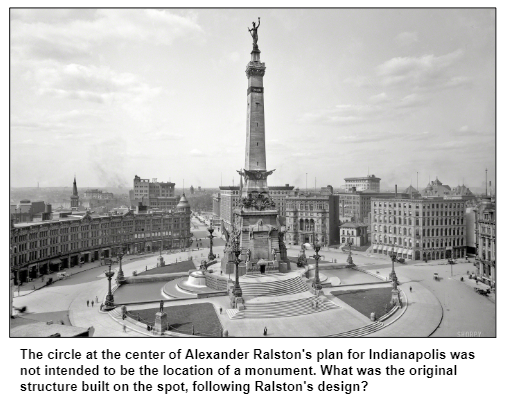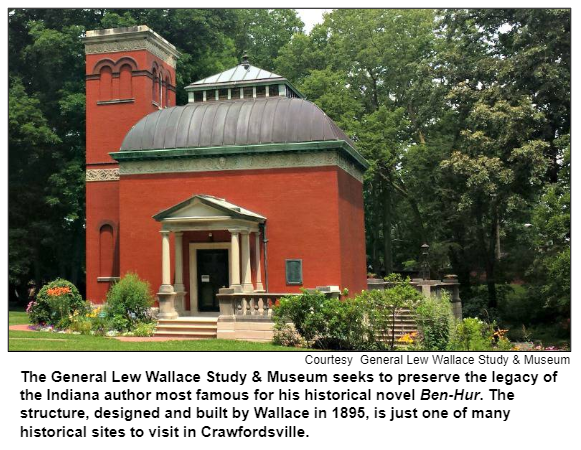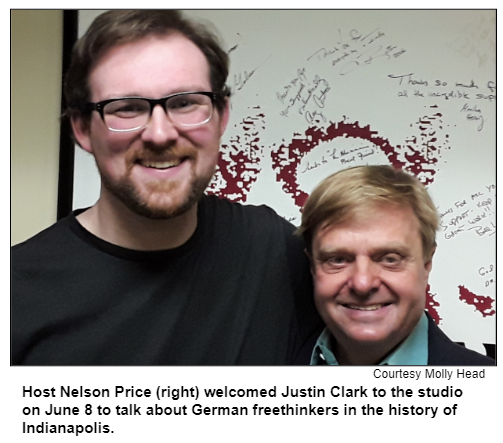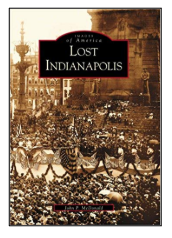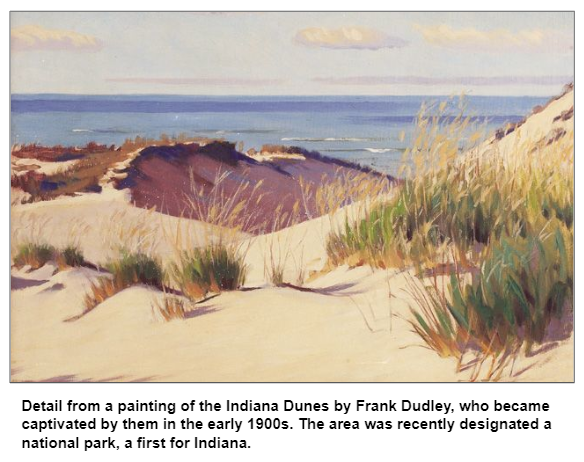
Saturdays, noon to 1 p.m. ET on WICR 88.7 FM.
Or listen live from anywhere on WICR Online!
Our call-in number during the show: (317) 788-3314
June 15, 2019
Earliest settlers of Indianapolis

In fact, in June of 1820 McCormick (1791-1825) hosted a meeting to identify the precise site of the new state capital, following an earlier gathering of top state leaders at the cabin of William Conner (namesake of Conner Prairie Interactive History Park.)
Today, a boulder with a commemorative plaque marks the historic site of McCormick's double cabin, which also included a tavern. The site is located in what is now White River State Park.

To share insights about the earliest settlers, Nelson's studio guests will be:
- Mike Todd, a retired truck driver who is descended from the McCormicks. Mike, a Ben Davis High School graduate who attended Indiana Central University (now the University of Indianapolis), lives on the west side of the city that his ancestors had such a key role in founding. Mike says that he only developed a passion for the city's history in recent years, although he recalls his grandmother taking him on Memorial Day to visit the commemorative boulder.
- And Jordan Ryan, coordinator of the Indianapolis Bicentennial Project for the Indiana Historical Society. She notes that, as part of a new archival collection for the Bicentennial Project, the society has transcribed the McCormick journal, which was obtained from a descendant who lives in North Carolina. Mike and Jordan persuaded his relative to ship the journal to Indianapolis for transcription.
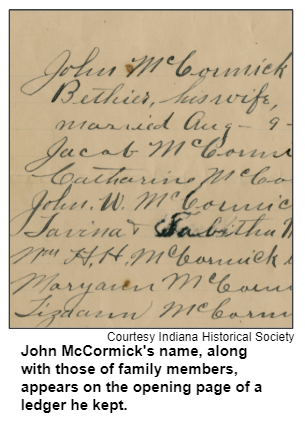
The historic McCormick journal is now available on the Indiana Historic Society website as a series of high-resolution digital images of each page.
The city's 200th birthday celebrations will extend into 2021 because Scottish-born surveyor Alexander Ralston actually platted the city in 1821, not 1820.
Ralston had helped design the original layout of Washington D.C. and used the plan for the nation's capital as an inspiration for his design of the new Hoosier capital. Hoosier History Live explored Ralston's life and impact during a show in 2013.
According to our guest Mike Todd, Ralston was a guest at John McCormick's tavern. McCormick later built the first sawmill in Marion County.
The McCormicks also ran a ferry service across the White River. "Part of the reason the site near the McCormick cabin was chosen [for the new state capital] was that the White River was seen as navigable and a vital component to the growth of the new city," according to Indianapolis: A Circle City History by Jeffrey Tenuth.

Meanwhile, early pioneer George Pogue vanished without a trace in 1821. The reason for his disappearance never has been determined conclusively.
A wooden table from the original McCormick cabin also vanished. Our guest Mike Todd is on a quest to find the historic table, which was donated to the Indiana State Museum in the 1920s by a McCormick descendant. (The state museum, which has moved twice since then, has said the cherry-wood table has been missing for decades.)
Some other history facts:
- McCormick's Creek State Park in Owen County is named in honor of the McCormick family.
- John McCormick had been a constable in Connersville. Pogue had been a blacksmith there.
- The 200th birthday celebrations are being organized by a bipartisan Indianapolis Bicentennial Commission co-chaired by former mayors Greg Ballard and Bart Peterson.
History Mystery
When surveyor Alexander Ralston designed the city of Indianapolis in 1821, he did not designate a monument at the center of what today is called Monument Circle. Construction of the Soldiers and Sailors Monument began much later in the city's history: during the 1880s, culminating with its dedication in 1902.
Instead, Ralston designed the circle in 1821 with the idea that a much different kind of structure would be at the center. Although the structure was built as planned, it never really was used for its intended purpose - and was eventually demolished.
Question: What was the initial structure built at the center of Indianapolis?
Please do not call in to the show until you hear Nelson pose the question on the air, and please do not try to win if you have won any other prize on WICR during the last two months. You must be willing to give your first name to our engineer, you must answer the question correctly on the air and you must be willing to give your mailing address to our engineer so we can mail the prize pack to you. This week's prizes: A pair of tickets to the Indiana History Center, courtesy of the Indiana Historical Society, and a gift certificate to Story Inn, courtesy of Story Inn.
Roadtrip: Crawfordsville Strawberry Festival and historic sites
Guest Roadtripper Jeff Kamm invites us to check out Crawfordsville, famous for their annual June Strawberry Festival. The festival is the largest tourist event in Montgomery County and is held at Lane Place, this historic home of Senator Henry S. Lane.
But the summer delight of perfectly ripe, freshly picked Fragaria ananassa (yes, that's the botanical name for cultivated strawberries!) isn't the only reason to come to Crawfordsville, Jeff assures us.
Less than 50 miles northwest of the state capital, Crawfordsville was declared the seat of Montgomery County in 1822 and has a variety of sites of interest to history-minded Hoosiers. Among the most famous is the study of General Lew Wallace, now a museum dedicated to the author of the epic novel Ben-Hur.
For those interested in criminal history, the town features the world's only operating rotary jail, also open to the public as a museum. And while the jail still rotates, don't worry - the criminals are long gone!
Another must-see stop on Jeff's Roadtrip: the recently restored clock tower of the county courthouse, a feature that had been missing since World War II. The list of Crawfordsvile's historic sites and attractions goes on… but we'll let Jeff tell you about them himself on this week's Roadtrip adventure!
Thinking (and talking) about German freethinkers in Indianapolis
Nelson Price, host and historian
Molly Head, producer/project manager, (317) 927-9101
Michael Armbruster, associate producer
Cheryl Lamb, administrative manager
Richard Sullivan, senior tech consultant
Pam Fraizer, graphic designer
Garry Chilluffo, special events consultant
Please tell our sponsors that you appreciate their support!

 Acknowledgments to Monomedia, Visit Indy, WICR-FM, Fraizer Designs, Heritage Photo & Research Services, Henri Pensis, Aaron Duvall, Chloe Tyson, and many other individuals and organizations. We are independently produced and are self-supporting through organizational sponsorship and through individual contribution at the yellow button on our newsletter or website. For organizational sponsorship, which includes logos, links, and voiced credits in the show, contact Molly Head at (317) 927-9101 or email her at molly@hoosierhistorylive.org. Our media reach continues to grow via podcasting and iTunes.
Acknowledgments to Monomedia, Visit Indy, WICR-FM, Fraizer Designs, Heritage Photo & Research Services, Henri Pensis, Aaron Duvall, Chloe Tyson, and many other individuals and organizations. We are independently produced and are self-supporting through organizational sponsorship and through individual contribution at the yellow button on our newsletter or website. For organizational sponsorship, which includes logos, links, and voiced credits in the show, contact Molly Head at (317) 927-9101 or email her at molly@hoosierhistorylive.org. Our media reach continues to grow via podcasting and iTunes.
Thank you!
We'd like to thank the following recent, new and renewal contributors whose donations help make this show possible!
- Perry and Melanie Hammock
- Jim and Bonnie Carter
- Barbara and Michael Homoya
- Noraleen Young
- Barbara Wellnitz
- Phil and Pam Brooks
- Russ Pulliam
- Roz Wolen
- Marion Wolen
- Richard Vonnegut
- Robin Jarrett
June 22, 2019 - coming up
The Indiana Dunes
Earlier this year, the Indiana Dunes made national news with the announcement that the distinctive shoreline on Lake Michigan would be a new national park, the first one in the state.
But does its designation as Indiana Dunes National Park - rather than the former Indiana Dunes National Lakeshore - make a substantive difference?
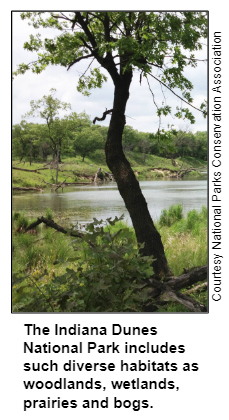
During our show, two guests will join Nelson by phone from their Porter County offices at the Dunes:
- Bruce Rowe, public information officer for Indiana Dunes.
- And Dustin Ritchea, promotions director for Indiana Dunes Tourism.
In an interview with the Indianapolis Star when the national park designation was announced in February, Dustin described the Indiana Dunes as one of the most biodiverse areas of North America - with more plant and animal species than Hawaii. In addition to sand dunes, Indiana Dunes includes woodlands, wetlands, prairies and bogs.
During the early 1900s, Chicago-based painter Frank Dudley became captivated by the dunes. He crusaded to have them preserved even as steel plants and other industrial development was occurring nearby in northwest Indiana. Carl Sandburg, who lived in Chicago, came to the dunes to write some of his poetry; he once called the dunes "eternity's signature."
Proposals to designate the Indiana Dunes as a national park started more than 100 years ago. In 1916, the first director of the National Park Service initially suggested the idea, according to The Indianapolis Star. The Indiana Dunes State Park was opened in 1926.
Attractions today include a 3 Dune Challenge, an endurance test in which visitors to the state park are challenged to climb its three tallest dunes. "The 1.5-mile trail takes participants up and down 552 vertical feet," according to the IBJ.
Although this will be our first show devoted exclusively to the Indiana Dunes, aspects of their heritage have come up during several previous Hoosier History Live programs. They have included:
- A show in 2018 about the House of Tomorrow and other showplace homes from the 1933 Chicago World's Fair. They were brought by barge to the Indiana Dunes resort town of Beverly Shores after the closing of the fair.
- And a show about bygone natural landmarks in 2016 that explored the Hoosier Slide, the tallest dune. It had disappeared by 1920 after its sand was hauled away for decades for use in commercial endeavors, particularly the glass-making industry.
© 2019 Hoosier History Live. All rights reserved.
|

